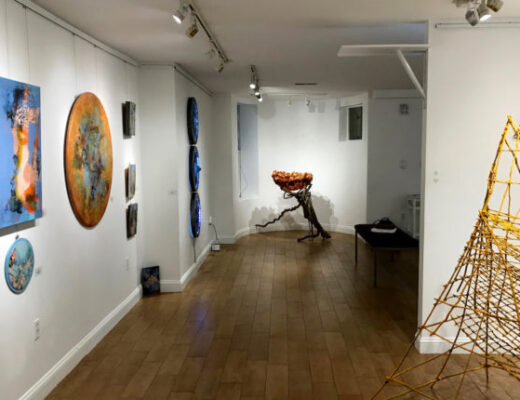by Oluseyi Akinyode
This article was originally published in DC Trending, here.
Walking on the trails near home, I’m filled with longing as cyclists swish by. There’s something about riding a bike — You can cover more terrain than by walking. Two weeks ago, I took the first step to fulfill that yearning by taking an adult biking class for beginners with a group of about 20 sponsored by the Washington Area Bicyclist Association (WABA). The group included ten Black people, and eight of them were women. It’s a rarely represented activity in my daily life and one that I find compelling given the perception that Black women don’t ride.
As part of my biking journey, I was intrigued to go check out Centuries, an immersive digital art installation by Nekisha Durrett at the K Street Virtual Gallery, honoring five Black women cyclists (Marylou Jackson, Velma Jackson, Ethyl Miller, Leolya Nelson, Constance White) who biked on a 250-mile journey over three days from NYC to Washington, DC in 1928.
Cycling represents not just physical mobility but also socio-economic mobility. It signifies the presence of leisure time beyond daily responsibilities and the presence of expendable income. It also lends itself to exploration and movement through space without barriers. The journey of these five Black women takes on audacious meaning considering the social and racial climate then.
The K Street Virtual Gallery is an initiative by NoMaBid that allows artists to create digital art installations projected onto the K Street underpass that sits between First and Second Streets NE as part of a broader revitalization of the area. According to the virtual gallery creators, it was their goal to create a space where people could stop, reflect, and enjoy their day. NoMa BID President Maura Brophy explained, “The gallery brings light and color to an otherwise dark space, but the rotating exhibits allow us to use the space to bring new pieces to the gallery and tell unique stories. The exhibits will change over time, allowing people to experience something new and exciting with each piece.”
The first K Street Virgual Gallery installation was created by artist My Ly, who used abstract colors and shapes moving across the walls of the underpass to render the multiplicities of transportation modes in the underpass.
This second installation, entitled Centuries and created by Durrett, continues the theme of movement from a different perspective by paying homage to the journeys of these five Black female cyclists. Projected onto the rough-hewn stones of the underpass are AI-generated images of ten Black women cyclists dressed in period outfits spanning the past to the future. The selection includes a cyclist from Victorian times, a nod to the possibility that Black women have ridden earlier than imagined. Texts like “WE OUTSIDE WE OUTSIDE” and “BLACK WOMEN CYCLE” amplify the theme of stories in motion.
A challenging cycling traverse was among the inspirations for Durrett’s installation. On a ride, the artist recalls suddenly hearing shouts from a group of Black women cyclists above — “Sis, you’ve got this; you’re so close. You’re walking the path of your ancestors.” Durrett believed that only with their encouragement did she emerge from the traverse. She shared that her goal for the exhibit was to remind us that “the paths we take have been paved by those who have gone before.”
This installation is in keeping with past works by the artist, such as Go-Go Belongs Here at the National Portrait Gallery, True Grit at James Madison University, and Don’t Forget to Remember (Me) in the cloisters at Bryn Mawr College. Employing text, materials, and imagery, these narratives tell the stories of individuals who have been forgotten while also envisioning limitless possibilities for the future that incorporate their unique experiences.
Durrett used AI to overcome artistic limitations, intending only to include photographs of Black women in the installation. However, the only available photo, most likely sourced from a Newspaper microfiche, was of poor quality and not suitable for reproduction. So Durett opted to use Midjourney, an AI application that generates images from texts. This allowed her to vividly portray Black women cycling, tying into Durrett’s practice of imagined realities. While sifting through AI-generated images for the installation, the artist couldn’t find images that captured her vision. So instead, she trained the AI model by inputting specific phrases to generate the images of the ten Black women featured in the installation. This experience serves as a reminder that the experiences of Black individuals may often be overlooked or forgotten in a rapidly advancing world driven by AI technology.
Given its recent past as a homeless encampment, an underpass filled only with passersby would be inadequate. The K Street Gallery is a clever approach that reflects a myriad of the city’s perspectives all the while embacing goals for redevelopment. In the future, after learning to ride, I may be one of those cyclists riding through the K Street underpass, continuing the journey of those who came before.
The K Street Gallery will feature a roster of installations by artists throughout the year. Artists, artist teams, and designers interested in participating in the K Street Virtual Gallery can contact events@nomabid.com. Centuries will be running for the next six months at the K Street Gallery, located close to 100 K St NE.





No Comments